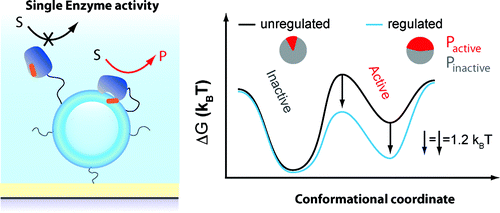当前位置:
X-MOL 学术
›
J. Am. Chem. Soc.
›
论文详情
Our official English website, www.x-mol.net, welcomes your
feedback! (Note: you will need to create a separate account there.)
Single Enzyme Studies Reveal the Existence of Discrete Functional States for Monomeric Enzymes and How They Are “Selected” upon Allosteric Regulation
Journal of the American Chemical Society ( IF 14.4 ) Pub Date : 2012-05-21 , DOI: 10.1021/ja3011429 Nikos S. Hatzakis , Li Wei , Sune K. Jorgensen , Andreas H. Kunding , Pierre-Yves Bolinger , Nicky Ehrlich , Ivan Makarov , Michael Skjot 1 , Allan Svendsen 1 , Per Hedegård 2 , Dimitrios Stamou
Journal of the American Chemical Society ( IF 14.4 ) Pub Date : 2012-05-21 , DOI: 10.1021/ja3011429 Nikos S. Hatzakis , Li Wei , Sune K. Jorgensen , Andreas H. Kunding , Pierre-Yves Bolinger , Nicky Ehrlich , Ivan Makarov , Michael Skjot 1 , Allan Svendsen 1 , Per Hedegård 2 , Dimitrios Stamou
Affiliation

|
Allosteric regulation of enzymatic activity forms the basis for controlling a plethora of vital cellular processes. While the mechanism underlying regulation of multimeric enzymes is generally well understood and proposed to primarily operate via conformational selection, the mechanism underlying allosteric regulation of monomeric enzymes is poorly understood. Here we monitored for the first time allosteric regulation of enzymatic activity at the single molecule level. We measured single stochastic catalytic turnovers of a monomeric metabolic enzyme (Thermomyces lanuginosus Lipase) while titrating its proximity to a lipid membrane that acts as an allosteric effector. The single molecule measurements revealed the existence of discrete binary functional states that could not be identified in macroscopic measurements due to ensemble averaging. The discrete functional states correlate with the enzyme's major conformational states and are redistributed in the presence of the regulatory effector. Thus, our data support allosteric regulation of monomeric enzymes to operate via selection of preexisting functional states and not via induction of new ones.
中文翻译:

单酶研究揭示了单体酶的离散功能状态的存在以及它们如何在变构调节下“选择”
酶活性的变构调节形成了控制大量重要细胞过程的基础。虽然多聚体酶的调控机制普遍被很好地理解并被提议主要通过构象选择进行操作,但对单体酶变构调控的机制却知之甚少。在这里,我们首次在单分子水平上监测了酶活性的变构调节。我们测量了单体代谢酶(Thermomyces lanuginosus 脂肪酶)的单个随机催化转化,同时滴定其与充当变构效应器的脂质膜的接近度。单分子测量揭示了离散二元功能状态的存在,由于整体平均而无法在宏观测量中识别。离散的功能状态与酶的主要构象状态相关,并在调节效应子存在的情况下重新分布。因此,我们的数据支持单体酶的变构调节通过选择预先存在的功能状态而不是通过诱导新的功能状态来操作。
更新日期:2012-05-21
中文翻译:

单酶研究揭示了单体酶的离散功能状态的存在以及它们如何在变构调节下“选择”
酶活性的变构调节形成了控制大量重要细胞过程的基础。虽然多聚体酶的调控机制普遍被很好地理解并被提议主要通过构象选择进行操作,但对单体酶变构调控的机制却知之甚少。在这里,我们首次在单分子水平上监测了酶活性的变构调节。我们测量了单体代谢酶(Thermomyces lanuginosus 脂肪酶)的单个随机催化转化,同时滴定其与充当变构效应器的脂质膜的接近度。单分子测量揭示了离散二元功能状态的存在,由于整体平均而无法在宏观测量中识别。离散的功能状态与酶的主要构象状态相关,并在调节效应子存在的情况下重新分布。因此,我们的数据支持单体酶的变构调节通过选择预先存在的功能状态而不是通过诱导新的功能状态来操作。















































 京公网安备 11010802027423号
京公网安备 11010802027423号